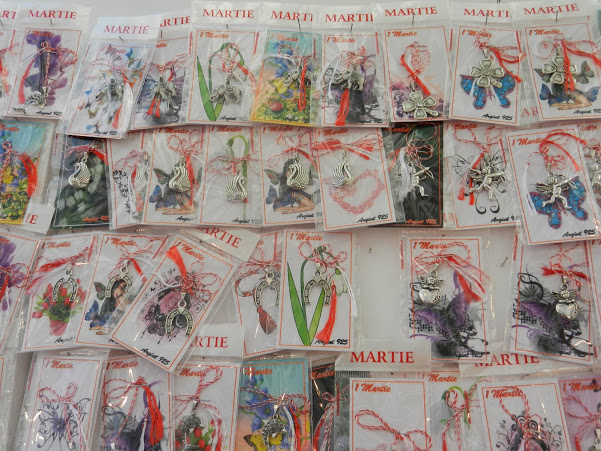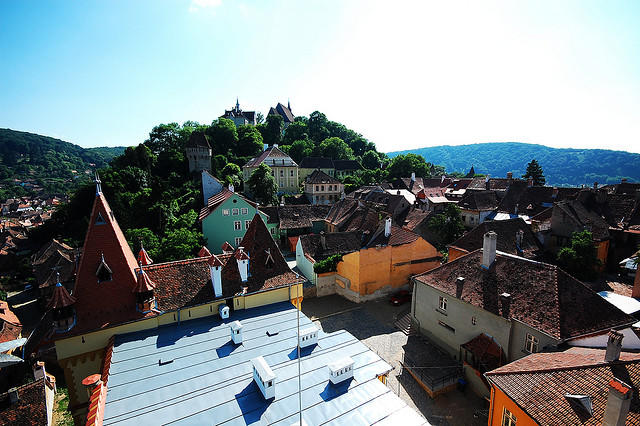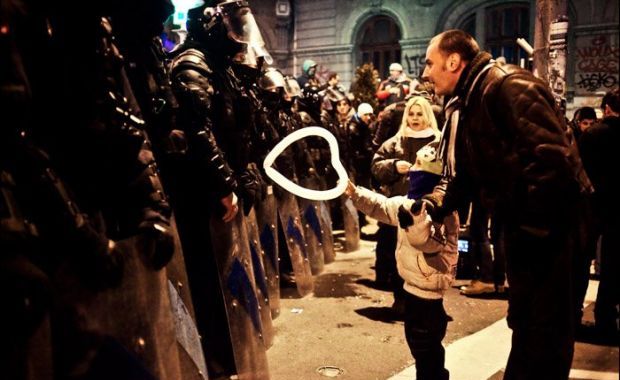Culture and Lifestyle
Romania Welcomes Spring with Martisor Day. History and Traditions
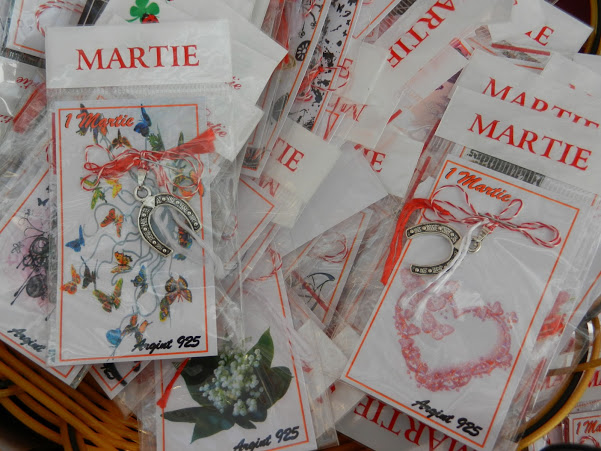
Attached to the Red-White string, there are
symbols considered to bring luck
Here – Horse shoe Martisor
As Spring begins, everything comes back to life. To mark the beginning of a new cycle of life, Romanians have a special tradition, called Martisor.
Origin of Martisor
The day of March 1, according to the old calendar, was considered the beginning of the New Year, the celebration of Spring’s arrival. Martisor is an over 8000 years old tradition, born in the lands where now Romania is. In the time of the Dacians (Romanian ancestors), spring symbols were made during winter and were worn starting with March 1st. Martisor were then white and red pebbles, strung on a string and worn around one’s neck. The red color, given by fire, blood and sun, was attributed to life, hence to women. White, on the other hand, conferred by the clarity of water, the white of the clouds, was specific to the wisdom of men. Besides, the cord of the Martisor expresses the inseparable interweaving of the two principle as a permanent movement of matter. It signifies the exchange of vital forces that give rise to life, the continuous cycle of nature.
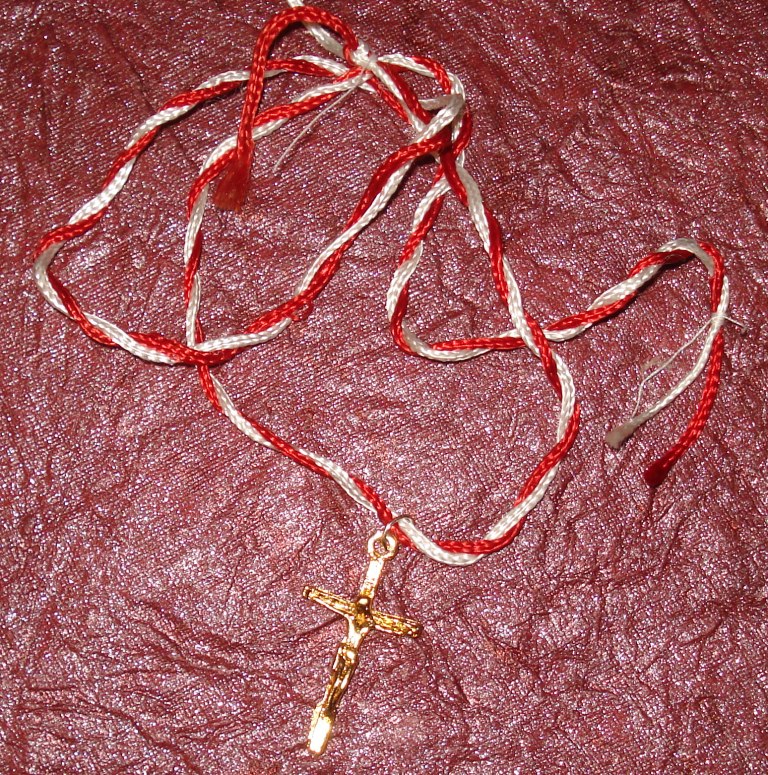
Martisor across the borders –
made by Sanskar Shrivastava in India
for TWR Romania team
The significance of Martisor remained the same over time: it’s a symbol of spring, of the returning to life. It brings optimism and faith. Back then, Martisor was attached to a rose or a blossoming tree, to bring luck, or was thrown in the direction from which wandering birds came, saying “Ia-mi negretele si da-mi albetele” (Take me the black and bring me the white” – meaning take away the surrow and everything negative and exchange it to happiness and good things).
Martisor Story
The legend says that the Sun descended in a village, at the village dance, taking the shape of a lovely girl. A dragon watched her and abducted her from the crowd and trapped her in a dungeon. The world was so sad. Birds stopped singing, rivers stopped flowing and children stopped laughing. Nobody dared to confront the dragon. But one day, a brave young man decided to go save the Sun. Many people led him and gave them from their powers to help him overcome the dragon and release the sun.
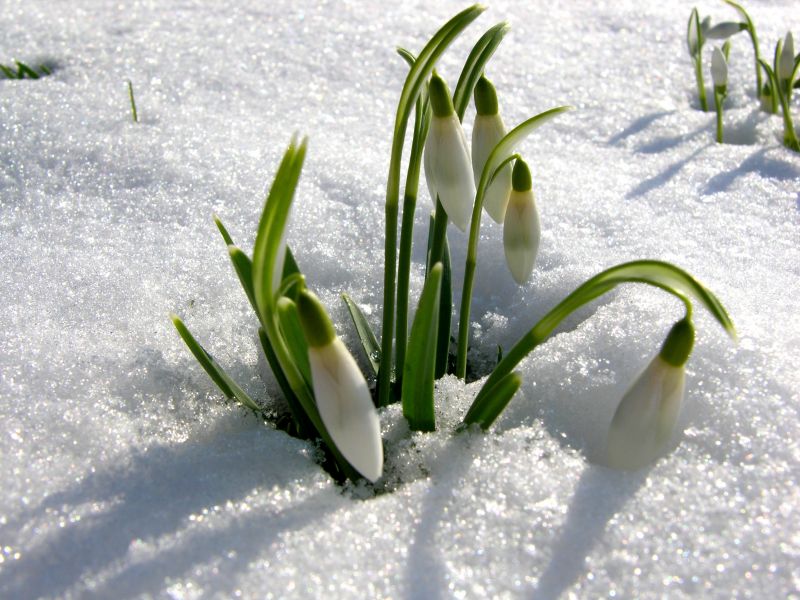
Snowdrops – Spring’s first flowers
The journey lasted three seasons: summer, autumn and winter. He found the dragon’s castle and they began fighting. They fought for days until the dragon was defeated. Feeble and wounded, the young man released the Sun. It rose in the sky, chearing up people. It revived nature, people have rejoiced, but the brave young man never got to see spring again. The hot blood from his wounds drained in the snow. While the snow was melting, white flowers were blooming, Snowdrops, the messengers of spring. Even the last drop of blood dripped in the pristine snow. He died. Since then, young people knit two tassels together: one white and one red. They offer them to the girls they love or to their loved ones. Red means love for all that is beautiful, reminiscent of the color of the brave man’s blood. White symbolizes the health and the purity of the snowdrop, the first flower of spring.
Martisor Traditions
Martisor is worn on “the days of Old Dochia” [Zilele Babelor] that are between 1 to 9 March. In present times, the custom is to pick a day from this period and it’s said that depending on how that day will be, that’s how all your year will be. A sunny day predicts a good year and a gloomy one a bad year.
In some regions, Martisor is worn during the whole month of March, then attached to the branches of a fruit tree. It is believed this will bring wealth into people’s homes. They say that if someone makes a wish and hang Martisor on the tree, it will come true soon. In early April, in a large part of Romania and Moldova’s villages, trees are decorated with Martisors. In Moldova, the musical festival “Martisor” takes place every year, starting on March 1 until March 10.
In some counties of Romania, Martisor is worn only in the first two weeks of March. In Transylvanian cities (center Romania), Martisors are hanged on doors, windows, horns of domestic animals, because it is considered that it can frighten evil spirits. In Bihor county it is believed that if people wash their face with rainwater fallen on March 1, they will become more beautiful and healthy. In Banat, girls wash with snow so they will be loved. In Dobrogea, Martisors are worn until the arrival of cranes, then thrown in the air so that their happiness will be great and have wings. In Moldova, on March 1 girls give Martisor to boys and they give them Martisors back on March 8 (this differs slightly from the rest of the country). The Festival of Martisor can be found in the Balkans at the Aromanians and Megleno-Romanians, as well at the Bulgarians who call it Marten/ Martenitsa (Мартеница) and also in Macedonia and Albania.
Wearing Martisor
Martisor can be basically any good-luck token that has attached the red-white martisor string. Most commonly used are the four-leaf-clover, the chimney sweeper, horse shoe and ladybug. Also, traditional models are ones made out of dry flowers casted in amber or small metal broches.

In the last years though, the trend has changed a bit and there are many who prefer wearing the bracelet Martisor (it’s like a friendship bracelet) – such as the ones below, as there are more and more people who like and do handmade designs.
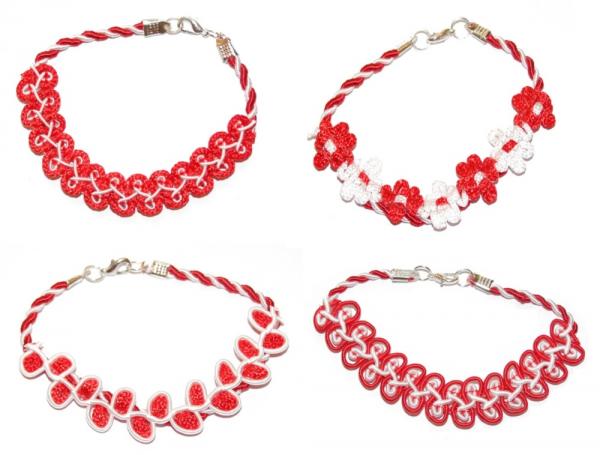
Martisor Bracelets
Apart from these rather traditional Martisor, you can gift/receive a martisor in so many other forms, from jewelry or scarfs to flowers that have attached one red-white string. One wears a Martisor either pinned on its tshirt/coat etc or tied around the wrist.
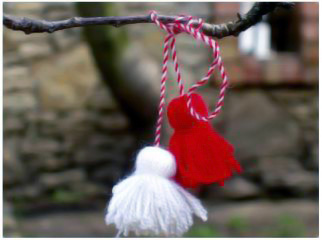
Martisor tied to a fruit tree
Either way you like to wear it and whatever model you prefer, we hope it would work it’s ‘magic’ and bring you a happy prosperous year
Culture and Lifestyle
Do you want to surprise a special someone?
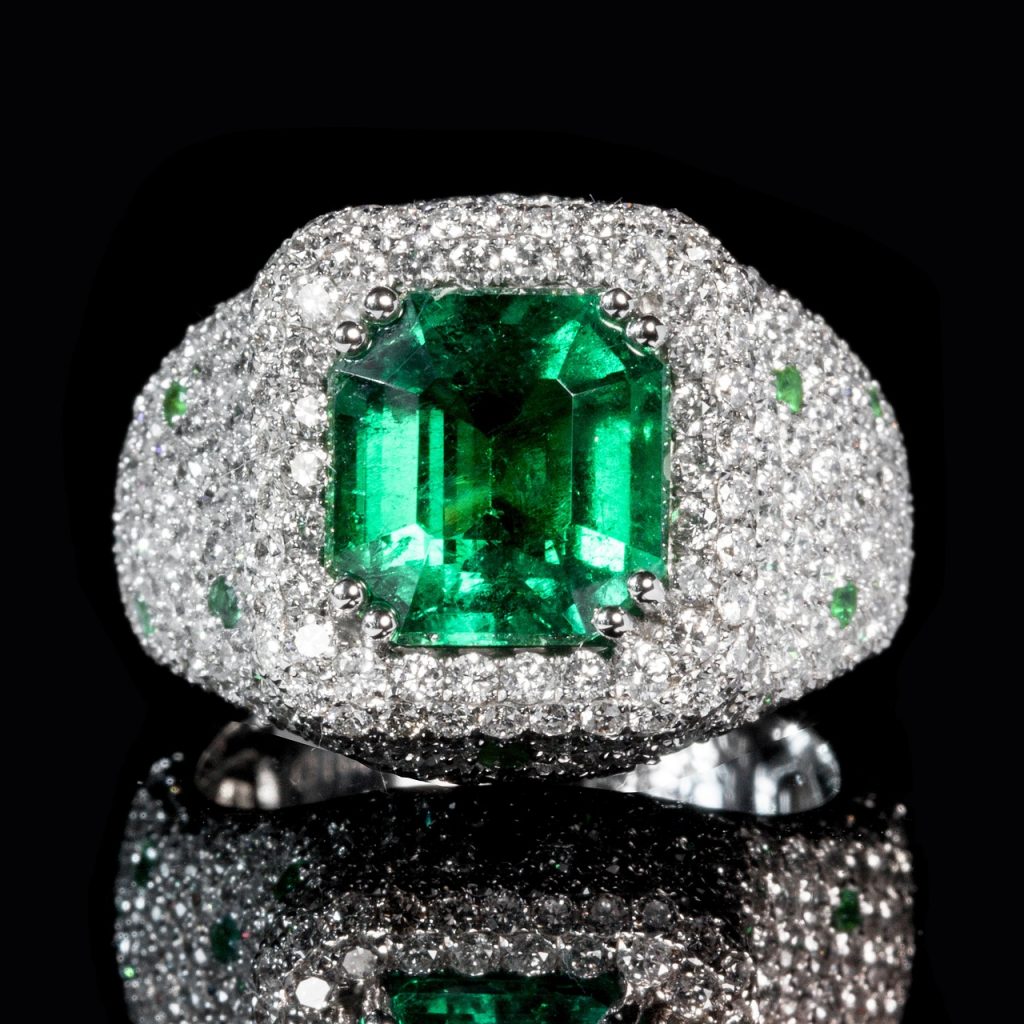
Precious and semi-precious stones have been highly valued throughout human history, not only because they are expensive, often symbolising status and luxury, but also because of their great symbolism—many even attribute mystical properties to them. Their indescribable beauty, powerful symbolic value, and economic worth make gifting gems a gesture full of meaning when you want to surprise and delight a loved one. Typically, precious stones are exquisitely set in jewellery—be it a ring, earrings, bracelets, or necklaces—becoming family treasures passed down through generations.
How to choose the perfect gem
The first thing to consider is who the gemstone is for and the occasion on which it will be given. One common occasion for gifting a gem is during a wedding proposal, traditionally in an engagement ring.
It’s essential to consider the recipient’s tastes, whether they love to wear standout pieces or prefer something more discreet. The quality of the gem is crucial, especially if this gift is meant to mark an important moment. For this reason, it should be purchased from reputable places with the best advice—two key aspects that define the store whynotgems, based in Madrid, Spain. Here, they don’t just sell gems commercially; they are passionate about them, putting in supreme effort and dedication, making a significant difference in the industry. The experts at WhyNotGems are constantly travelling around the world to acquire the finest stones, which they then offer to their clients with the most competitive quality-price ratio. They have a versatile online store offering a wide variety of gems, jewellery, and settings to choose from, tailored to individual tastes and preferences.
Another essential aspect to consider when picking a gem is the budget. The price range is very broad, depending on the size, quality, and type of gem. Diamonds, commonly used in engagement rings, are generally the most expensive. Some opt for more affordable but equally beautiful options, such as emeralds, sapphires, topazes, and rubies, which also vary in price depending on their quality and the jewellery in which they are set.
Some characteristics that denote the quality of a stone include its lack of imperfections, vivid colour, and clear transparency. This not only enhances its beauty but also ensures its longevity.
Gems and their meanings
When gifting a stone to a loved one, you’re expressing something. They are more than just a beautiful adornment; they carry significant meaning, so it’s important to understand their symbolism to let the gift speak for itself. For example, diamonds are associated with eternal love, which is why they are the traditional stone for engagements. Sapphires, with their characteristic deep blue, symbolise nobility and loyalty and are often exchanged between friends and family. When you give this gem to a loved one, it conveys that you greatly value your relationship, whether it’s a friendship or family bond. It also signifies a desire to protect the other person during difficult times. Those who love passionately tend to choose rubies, with their characteristic deep red. These gems are typically gifted on wedding anniversaries, as they denote the intensity of a feeling that grows over time.
It’s important to remember that the meanings of stones vary according to individual cultures and beliefs. Some people place more weight on the metaphysical properties of gems, while others are simply enchanted by their aesthetic appeal. Either way, giving a stone will always be a great way to please a loved one on a special occasion.
In conclusion, gifting a gemstone is more than just giving a beautiful piece of jewellery; it’s a timeless gesture filled with deep meaning and thoughtfulness. Whether chosen for its symbolism, aesthetic appeal, or as a treasured keepsake, a gem is a perfect way to express love, appreciation, and commitment to someone special.
Culture and Lifestyle
The visionary Spanish artist makes a milestone in the art industry and human science
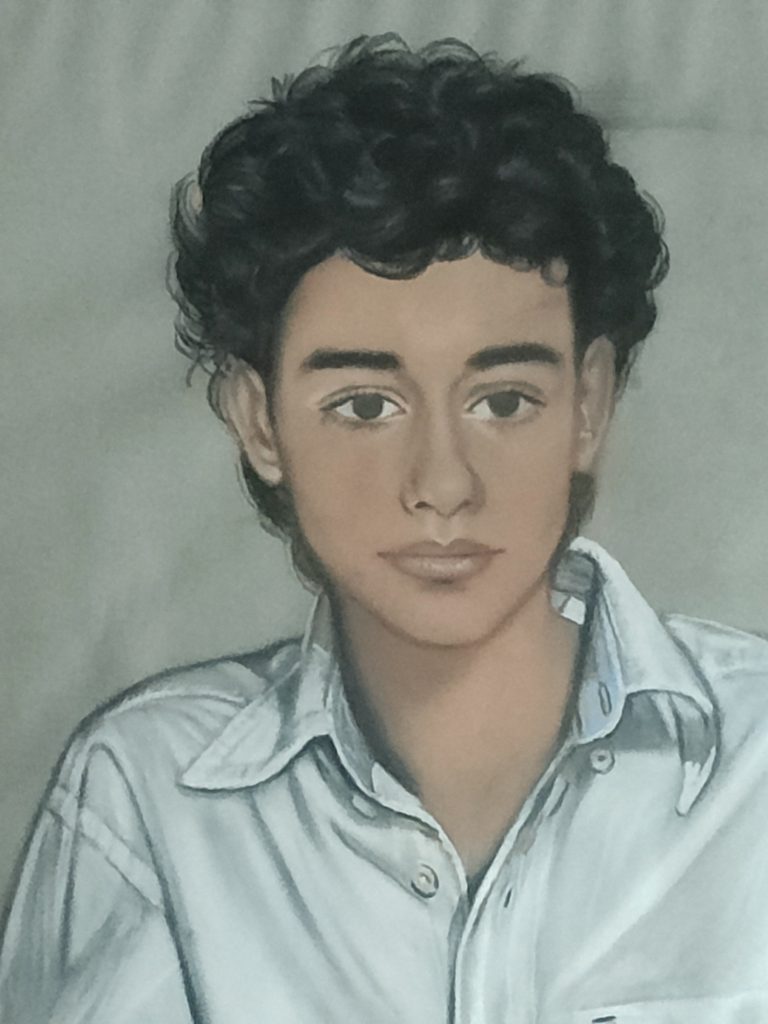
The art industry is buzzing with the incredible news of a Spanish artist, Eduardo Vidal, who has achieved an unparalleled milestone in both art and human science. His work can be described as visionary, a term that only few artists are able to live up to. While his works have been featured in some of the world’s most prestigious galleries and museums, Eduardo Vidal art remains humble about his talent.
Eduardo Vidal has developed an original style that blurs the lines between surrealism and minimalism. He uses color theory to create pieces that are both complex yet simple at the same time; he also combines techniques from traditional painting with modern digital technology to create intricate designs. His work is praised for its innovative approach which speaks directly to viewers’ emotions and encourages them to think differently about the world around them.
Art Industry Impact
Art has been a form of expression for centuries, and it continues to be an important part of our culture today. In recent years, the art industry has seen tremendous growth and development as more people turn to art as a means of communication. One artist who is making waves in the industry is Spanish visionary artist Miguel Molinez. He recently achieved a milestone that could have long-term implications not just for the art world, but also for human science.
Molinez’s innovative technique combines the traditional principles of painting with modern digital technology, creating unique works that have captivated audiences around the world. His creative approach to creating artwork has yielded ground-breaking results in both aesthetics and scientific accuracy. His most recent project which involved recreating an ancient historical moment using light was so successful that it could open up new possibilities in terms of exploring our past through visual arts.
Human Science Revolution
The Spanish artist, Carlos Bermejo, has just made a monumental breakthrough in the art and science worlds. His unique approach to incorporating elements of human science into his artwork is revolutionizing the way people think about art. With an emphasis on connecting human emotion and experience with scientific models, he is paving the way for a new era of expressionism.
Bermejo’s latest masterpiece incorporates theoretical physics principles to explore the relationship between time and space. This ambitious project has gained global attention as it bridges both art and science by exploring how humans interact with their environment on an individual level. His work provides a platform for viewers to consider their own place within this world by reflecting on its beauty, mystery, and complexity.
The conclusion of the article regarding Spanish artist’s milestone has been monumental. Spanish visionary artist, Eduardo Vidal, has made a lasting mark on the art industry and human science alike. This new milestone is considered groundbreaking, as it has observed the way humans interact with their environment by utilizing scientific principles and innovative techniques to create meaningful works of art.
Eduardo Vidal success in this field proves that there are no boundaries when it comes to creating meaningful works of art. Through his work, Eduardo Vidal was able to bring together different disciplines such as science and art, highlighting how intricately intertwined they truly are. The impact of his contribution is undeniable; not only has he created incredible works of art, but he also helped bridge the gap between creative fields and opened up new possibilities for exploration in the future.
Culture and Lifestyle
Spend All Your Time Online? Hobbies That’ll Get You More Hands On

If you find yourself always online, it’s best to turn off the computer or phone and find something else to do. However, that’s a lot easier said than done! But if you’ve got a hands-on hobby in your back pocket, you’ll always have something fun and practical to turn to when you get bored.
Staring at a screen all day isn’t healthy for you, and it’s good to find real ways to rest your eyes and get outside a bit more. As such, here are some ideas regarding the kinds of hobbies that’ll help you find enjoyment in things other than what’s going on online.
Woodworking
If you’ve ever fancied yourself as a carpenter, this is the first step on your journey to putting huge items of furniture together for your own home. Get a bit of wood, get a carving knife, and see how you can manipulate the material to make something interesting. Take precautions and protect your hands, but have fun at the same time. And while you’ve not got a woodworking shop yet, even just a small set of tools can help you whittle your way to new cutlery, decorative figurines, and incredibly personal birthday and anniversary presents.
Building Models
Miniatures are a very popular hobby, and all thanks to the time and love we have to put into making them. And when you’re a fan of building your own models, you can move into other item builds, such as attaching 80 lower receiver jigs to a rifle project of your own. But to get started, all you need is a set of models to crack open, snip off, and glue together. Once you’re done with this, you can start painting them and even put together your own playing team. It’s not just a one step hobby you can then display in a cabinet – there’s a lot of nuance to explore.
Gardening and Landscaping
Gardening is a totally free hobby to pick up if you’ve already got a garden. You can take cuttings from bushes, trees, and plants that you see out and about and then try to cultivate the same greenery in your own garden. Indeed, it’s a great way to blow off steam as well as get your hands dirty, which is something a screen just won’t allow! But if you prefer cutting back in the garden, you can try out landscaping instead, which will help you to design the outdoor space you’ve always wanted to relax in.
Bake Your Own Bread
Baking is one of the best hands-on hobbies out there. Why? Because you get to eat something when you’re finished. And baking bread is quite the artform, so you’ll need to really brush up on your skills here. Plus, a freshly baked loaf every morning is always something to look forward to – it’s just the cleaning that’s annoying!
If you’re always online, it’s time to break the habit! Get out and remind yourself there are other things to enjoy.
-

 Business11 months ago
Business11 months agoHow To Future-Proof Your Business With The Right Tools
-
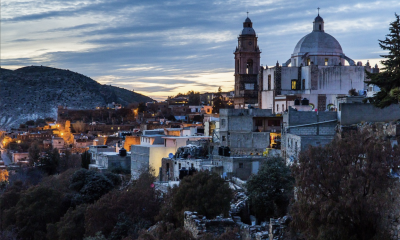
 Travel9 months ago
Travel9 months agoTravelling from San Antonio to Guadalajara
-

 Business12 months ago
Business12 months agoWhat are EDC products, and why should you always have them?
-

 Travel6 months ago
Travel6 months agoTravel wellness tips for a healthier and more enjoyable journey
-

 Europe5 months ago
Europe5 months agoRecent Books by Boaventura de Sousa Santos: Law, Colonialism, and the Future of Europe

